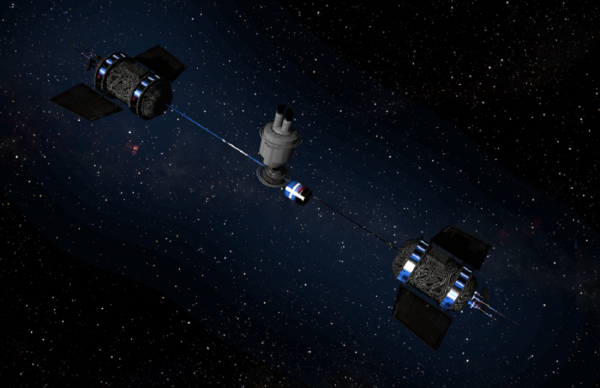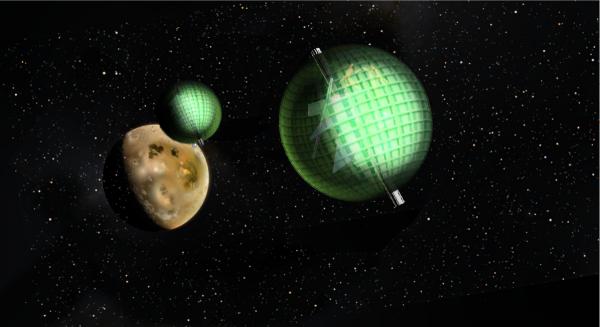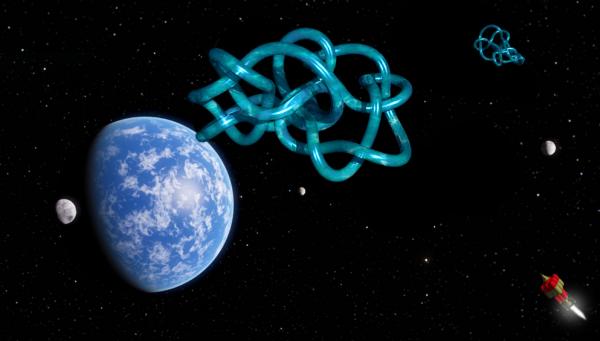BY LETTER
Singlehabs
Space Habitats occupied by small groups, families or single individuals | |
 Image from Steve Bowers | |
| A pair of tethered singlehabs, rotating to generate artificial gravity | |
Also known as Starsteads, Kin-Stations and Space Cottages. A singlehab is a self contained space habitat designed for long term occupation by small groups or individuals. On average ten-twenty sophonts reside in one hab, typically a few families or a large peer-group, rarely are populations approaching one hundred to be found. Singlehabs are very common throughout the Terragen sphere, particularly in dense orbital band civilisations where they often occupy higher orbits to prevent clutter.
Singlehabs are arguably the oldest class of space habitat, indeed the very first stations built in Earth orbit held only a handful of baseline humans and animals for scientific and commercial projects. They persisted throughout the Interplanetary Age even as larger habitats were built, mostly used as research outposts or luxury retreats for the wealthy. The technocalypse saw the destruction or abandonment of almost all such habs. Being of small size they were not self-sustaining, running out of supplies and spare parts within months. A rare few managing to last years but the vulnerability embedded a cautious attitude regarding small habs in the post-Technocalypse world. It would not be until the Age of Establishment, when CELSS and autofabrication technology had progressed far enough, that singlehabs would again be built in large numbers. From this point on self-sufficient space habitats for small communities and kin groups have been a staple feature across the Terragen Sphere. Given their small nature (both in physical size and community) the designs, styles and uses of singlehabs are incredibly diverse. In some cases aesthetics is prioritised over function, most famously in the case of the Petit Orbital Band within which each hab is modeled on an idealised rural cottage. In lieu of a comprehensive review the following list is comprised of common or notable singlehabs used in the Terragen Sphere:
Tethered Modules: For clades that prefer to live with gravity a standard singlehab design consists of two or more rotating habitation modules (similar in size to large terrestrial dwellings) connected by one or more thin, strong tethers. This "string and buckets" design (as it's sometimes known) has endured for millennia, offering a good degree of flexibility and comfort for little mass. A central module provides counter rotating airlocks for inter-orbital shuttles to dock with. The tethers not only allow for a rotating structure but also act as elevator cables for transport between modules. It's not uncommon to find one module used for general habitation with the other reserved for domestic industry and storage. In addition gardens are popular uses for the upper floor with a transparent dome for protection and stunning views. Overall length tends to be between one and five kilometers, depending on desired gravity and angular velocity.
 Image from Steve Bowers | |
| Inflatable Singlehabs near the Io-like world KIlauea | |
Inflatable Bubble: This non rotating form is ideal for small groups of microgravity adapts. Again the design is simple and ancient; a suitable balloon structure is inflated in orbit to form a pressurised sphere, usually 50-200m in diameter. The interior is filled by a sponge-like arrangement of support struts upon which rooms, equipment and flora can be attached. Transparent hulls are a popular option, allowing residents an all-around view of the wider universe.
Conglomerate: Amongst the most diverse of designs conglomerate singlehabs are an eclectic collection of modular units arranged in whatever manner the residents wish. Their popularity has risen and fallen throughout space and time, usually following fads for ancient or classical designs (conglomerate singlehabs often resemble early space stations). They also tend to house the largest populations, several family groups or a single clan of peers. Most are microgravity environments but rotating designs are common as well, the latter are often likened to skeletal diskworlds or Bernal spheres.
Vacuum Reefs: Popular with vacuum adapt clades, whether they be biont or vec, this class of singlehab can be envisioned as an inside-out space station. In many cases they do not resemble the coral organisms for which they are named, rather 3D-fractal shapes are prefered to maximise area. The surface of these structures are commonly densely covered in vacuum adapted flora (biological or mechanical) and provide feeding, manufacturing and recreational facilities for vacuum adapted clades. In orbital bands with many vacuum reefs residents tend to be transient, staying at one reef for a time before nomadically setting out for another.
 Image from Steve Bowers | |
| Knotted Aquaria near the waterworld Eurybia | |
Rockhugger: A popular belter habitat design attached or tunneled into small asteroids. A highly diverse class rockhuggers come in many shapes and sizes from modules running on radial tracks for gravity to small dyson trees with interior rooms. The decision to build this type of singlehab over others is usually motivated by a desire to utilize the asteroid for construction material, fuel, radiation shielding or as a (weak) gravity source. More often than not rockhuggers eventually grow beyond their singlehab status, becoming larger habitat communities as more and more of the asteroid is used as construction material.
Virch Node: Also known as a "server hab" this small satellite design consists largely of computronium and ancillary systems to run a virch for a small group of digital sophonts. Virch nodes can commonly be found as part of a swarm of similar habs as part of an orbital band or even a Matrioshka brain.
Related Articles
Appears in Topics
Development Notes
Text by Ryan B
Initially published on 28 November 2016.
Initially published on 28 November 2016.






